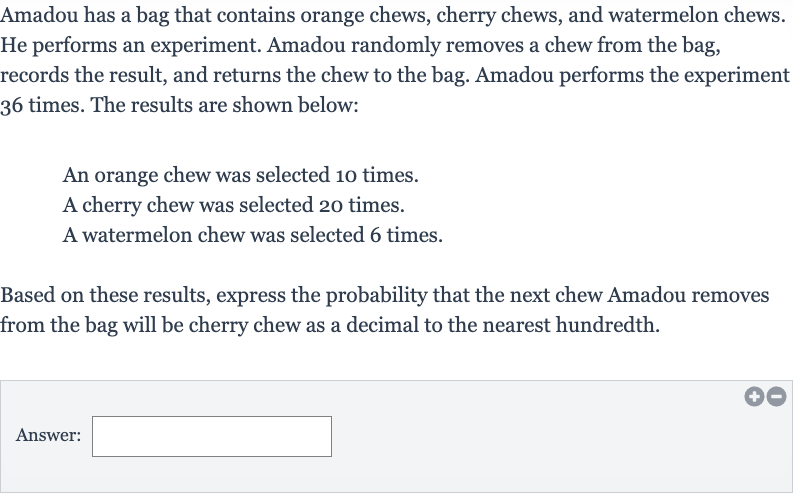AI tutor
Welcome to Bytelearn!
Let’s check out your problem:

Amadou has a bag that contains orange chews, cherry chews, and watermelon chews. He performs an experiment. Amadou randomly removes a chew from the bag, records the result, and returns the chew to the bag. Amadou performs the experiment times. The results are shown below:An orange chew was selected times.A cherry chew was selected times.A watermelon chew was selected times.Based on these results, express the probability that the next chew Amadou removes from the bag will be cherry chew as a decimal to the nearest hundredth.Answer:
Full solution
Q. Amadou has a bag that contains orange chews, cherry chews, and watermelon chews. He performs an experiment. Amadou randomly removes a chew from the bag, records the result, and returns the chew to the bag. Amadou performs the experiment times. The results are shown below:An orange chew was selected times.A cherry chew was selected times.A watermelon chew was selected times.Based on these results, express the probability that the next chew Amadou removes from the bag will be cherry chew as a decimal to the nearest hundredth.Answer:
- Total Experiments Determination: Determine the total number of experiments conducted by Amadou.Amadou performed the experiment times.
- Cherry Chew Selection: Determine the number of times a cherry chew was selected. A cherry chew was selected times.
- Cherry Chew Probability Calculation: Calculate the probability of selecting a cherry chew. Probability of selecting a cherry chew =
- Probability Decimal Conversion: Convert the probability to a decimal.
- Decimal Rounding: Round the decimal to the nearest hundredth.
More problems from Find probabilities using the binomial distribution
QuestionGet tutor help
QuestionGet tutor help
QuestionGet tutor help
QuestionGet tutor help
QuestionGet tutor help
QuestionGet tutor help
QuestionGet tutor help
QuestionGet tutor help
QuestionGet tutor help
QuestionGet tutor help
